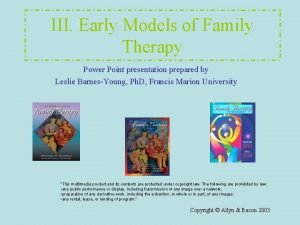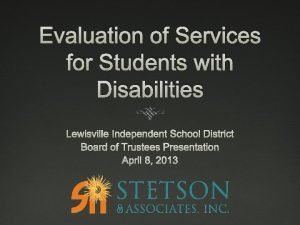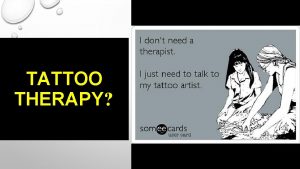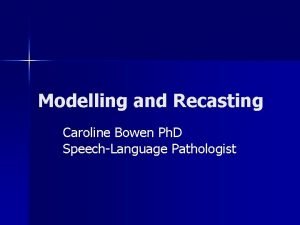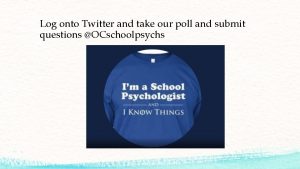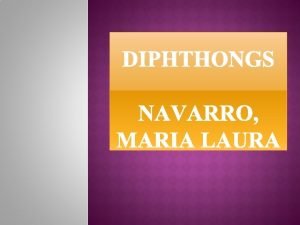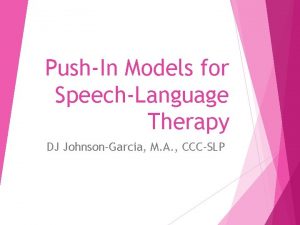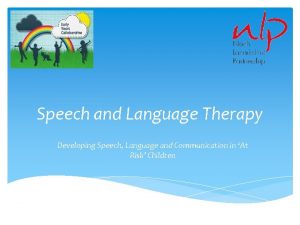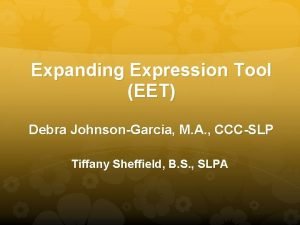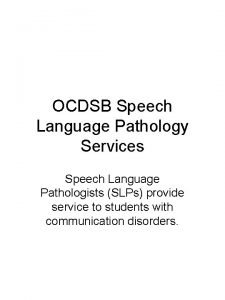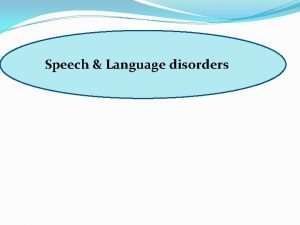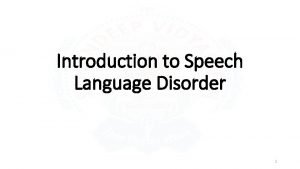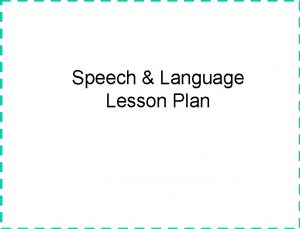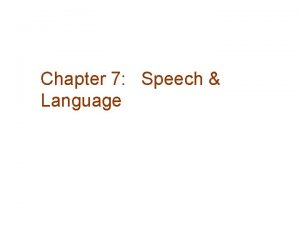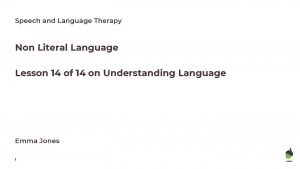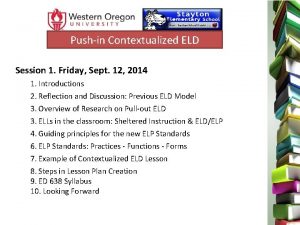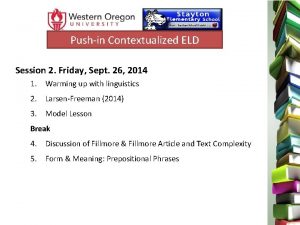PushIn Models for Speech Language Therapy DJ JohnsonGarcia






















- Slides: 22

Push-In Models for Speech. Language Therapy DJ Johnson-Garcia, M. A. , CCC-SLP Tiffany Sheffield, B. S. , SLPA

CSAD 223: • For test 3, you only need to know the slides that have a ** •

Whole Group & Stations** • Whole group works with the entire classroom all at the same time. • Stations divide students into groups of 2 -4 and offers opportunities to have students work on different activities.

Expanding Expression Tool (EET) By Sara Smith** • Primary language development component is semantics • EET can also assist in developing morphology and syntax

Student Samples Provided by EET author Sara Smith, MS, CCC-SLP 8/18/2011 at SJUSD In-Service Seminar

How to Begin EET** • Introduce EET using a common item or object • Teach students the symbol-diddy to aid retention • Have students use the EET to describe an object or item • Optionally - Create craft activity for students to construct personal prompting tools for future use

Push-In Games and Activities to Reinforce Skills • Round Robin with Descriptions/Attributes • “Headbandz” type activity • Mystery Box Items • Musical Dots/Cakewalk type activity • Baseball activity • Relay-race teams

Expanding From Oral to Written Expression** • Use as pre-writing organizers • More detailed WH? focus for information gathering (Research) • Assist student in creating more detailed comparison and contrast work

Compare/Contrast • Apple • Fruit • Eat it • Round, red • Water, vitamins • Peel, flesh, stem • Orchard • Bake Pies, juice, applesauce • Banana • Fruit • Eat it • Crescent, yellow • Water, vitamins • Peel, flesh, stem • Tropical bush • Monkeys love them

Communication Lab** (Social) Language A Program on Pragmatic By Ellen Pritchard Dodge • A 10 -week program designed to help children to become effective communicators by teaching them how to communicate. • Role Playing is at the heart of Communication Lab • Role Playing the wrong way and then the right way – removes negative in-the-moment emotions making it easier for students to process and respond in a more effective and cooperative manner. • And it’s so much fun that they love it!

What Do Good Communicators Do? • Eye Contact

What Do Good Communicators Do? • Eye Contact • Turn-Taking

What Do Good Communicators Do? • Eye Contact • Turn-Taking • Vocal Volume

What Do Good Communicators Do? • Eye Contact • Turn-Taking • Vocal Volume • Adequate Distance (Proximity, Personal Space)

What Do Good Communicators Do? • Eye Contact • Turn-Taking • Vocal Volume • Adequate Distance (Proximity, Personal Space) • Body Language

What Do Good Communicators Do? • Eye Contact • Turn-Taking • Vocal Volume • Adequate Distance (Proximity, Personal Space) • Body Language • Listening

What Do Good Communicators Do? • Eye Contact • Turn-Taking • Vocal Volume • Adequate Distance (Proximity, Personal Space) • Body Language • Listening • Observation

What Do Good Communicators Do? • Eye Contact • Turn-Taking • Vocal Volume • Adequate Distance (Proximity, Personal Space) • Body Language • Listening • Observation • Praise

What Do Good Communicators Do? • Eye Contact • Turn-Taking • Vocal Volume • Adequate Distance (Proximity, Personal Space) • Body Language • Listening • Observation • Praise • The Way (Tone of Voice)

What Do Good Communicators Do? • Eye Contact • Turn-Taking • Vocal Volume • Adequate Distance (Proximity, Personal Space) • Body Language • Listening • Observation • Praise • The Way (Tone of Voice) • Stay on Subject (Topic Maintenance)

What Do Good Communicators Do? • Eye Contact • Turn-Taking • Vocal Volume • Adequate Distance (Proximity, Personal Space) • Body Language • Listening • Observation • Praise • The Way (Tone of Voice) • Stay on Subject (Topic Maintenance) • Rate of Speech

What Do Good Communicators Do? ** • Eye Contact • Turn-Taking • Vocal Volume • Adequate Distance (Proximity, Personal Space) • Body Language • Listening • Observation • Praise • The Way (Tone of Voice) • Stay on Subject (Topic Maintenance) • Rate of Speech • Clarity of Speech
 Psychoanalytic therapy is to as humanistic therapy is to
Psychoanalytic therapy is to as humanistic therapy is to Bioness integrated therapy system occupational therapy
Bioness integrated therapy system occupational therapy Psychoanalytic therapy is to as humanistic therapy is to
Psychoanalytic therapy is to as humanistic therapy is to Models of family therapy ppt
Models of family therapy ppt What are modals and semi modals
What are modals and semi modals Lewisville speech therapy evaluation
Lewisville speech therapy evaluation Informative speech on tattoos
Informative speech on tattoos Oral placement therapy
Oral placement therapy Recasting in speech therapy
Recasting in speech therapy Speech therapy bell curve
Speech therapy bell curve A vowel which remains constant and does not glide
A vowel which remains constant and does not glide Formuö
Formuö Typiska novell drag
Typiska novell drag Nationell inriktning för artificiell intelligens
Nationell inriktning för artificiell intelligens Returpilarna
Returpilarna Varför kallas perioden 1918-1939 för mellankrigstiden?
Varför kallas perioden 1918-1939 för mellankrigstiden? En lathund för arbete med kontinuitetshantering
En lathund för arbete med kontinuitetshantering Adressändring ideell förening
Adressändring ideell förening Tidbok för yrkesförare
Tidbok för yrkesförare A gastrica
A gastrica Förklara densitet för barn
Förklara densitet för barn Datorkunskap för nybörjare
Datorkunskap för nybörjare Tack för att ni lyssnade bild
Tack för att ni lyssnade bild



